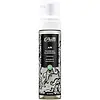What's inside
What's inside
 Key Ingredients
Key Ingredients

 Benefits
Benefits

 Concerns
Concerns

 Ingredients Side-by-side
Ingredients Side-by-side

Water
Skin ConditioningGlycerin
HumectantGlycolic Acid
BufferingSodium C14-16 Olefin Sulfonate
CleansingCocamidopropyl Betaine
CleansingPropylene Glycol
HumectantSalicylic Acid
MaskingCitric Acid
BufferingSodium Hydroxide
BufferingCamellia Sinensis Leaf Extract
AntimicrobialSaccharide Isomerate
HumectantAloe Barbadensis Leaf Extract
EmollientCentella Asiatica Extract
CleansingEucalyptus Globulus Oil
Melaleuca Alternifolia Leaf Oil
AntioxidantPhenoxyethanol
PreservativeEthylhexylglycerin
Skin ConditioningWater, Glycerin, Glycolic Acid, Sodium C14-16 Olefin Sulfonate, Cocamidopropyl Betaine, Propylene Glycol, Salicylic Acid, Citric Acid, Sodium Hydroxide, Camellia Sinensis Leaf Extract, Saccharide Isomerate, Aloe Barbadensis Leaf Extract, Centella Asiatica Extract, Eucalyptus Globulus Oil, Melaleuca Alternifolia Leaf Oil, Phenoxyethanol, Ethylhexylglycerin
Water
Skin ConditioningAmmonium Lauryl Sulfate
CleansingDisodium Cocoamphodiacetate
CleansingAcrylates Copolymer
Perlite
AbsorbentGlycerin
HumectantPropylene Glycol
HumectantMandelic Acid
AntimicrobialCitric Acid
BufferingCamellia Sinensis Extract
AntioxidantPunica Granatum Extract
AstringentMentha Piperita Oil
MaskingButylene Glycol
HumectantHydrastis Canadensis Extract
MaskingHumulus Lupulus Extract
AntimicrobialEquisetum Hyemale Extract
Skin ConditioningCymbopogon Schoenanthus Extract
Skin ConditioningMethylisothiazolinone
PreservativeHamamelis Virginiana Extract
AntiseborrhoeicSodium Hydroxide
BufferingParfum
MaskingCI 19140
Cosmetic ColorantWater, Ammonium Lauryl Sulfate, Disodium Cocoamphodiacetate, Acrylates Copolymer, Perlite, Glycerin, Propylene Glycol, Mandelic Acid, Citric Acid, Camellia Sinensis Extract, Punica Granatum Extract, Mentha Piperita Oil, Butylene Glycol, Hydrastis Canadensis Extract, Humulus Lupulus Extract, Equisetum Hyemale Extract, Cymbopogon Schoenanthus Extract, Methylisothiazolinone, Hamamelis Virginiana Extract, Sodium Hydroxide, Parfum, CI 19140
Ingredients Explained
These ingredients are found in both products.
Ingredients higher up in an ingredient list are typically present in a larger amount.
Citric Acid is an alpha hydroxy acid (AHA) naturally found in citrus fruits like oranges, lemons, and limes.
Like other AHAs, citric acid can exfoliate skin by breaking down the bonds that hold dead skin cells together. This helps reveal smoother and brighter skin underneath.
However, this exfoliating effect only happens at high concentrations (20%) which can be hard to find in cosmetic products.
Due to this, citric acid is usually included in small amounts as a pH adjuster. This helps keep products slightly more acidic and compatible with skin's natural pH.
In skincare formulas, citric acid can:
While it can provide some skin benefits, research shows lactic acid and glycolic acid are generally more effective and less irritating exfoliants.
Most citric acid used in skincare today is made by fermenting sugars (usually from molasses). This synthetic version is identical to the natural citrus form but easier to stabilize and use in formulations.
Read more about some other popular AHA's here:
Learn more about Citric AcidGlycerin is already naturally found in your skin. It helps moisturize and protect your skin.
A study from 2016 found glycerin to be more effective as a humectant than AHAs and hyaluronic acid.
As a humectant, it helps the skin stay hydrated by pulling moisture to your skin. The low molecular weight of glycerin allows it to pull moisture into the deeper layers of your skin.
Hydrated skin improves your skin barrier; Your skin barrier helps protect against irritants and bacteria.
Glycerin has also been found to have antimicrobial and antiviral properties. Due to these properties, glycerin is often used in wound and burn treatments.
In cosmetics, glycerin is usually derived from plants such as soybean or palm. However, it can also be sourced from animals, such as tallow or animal fat.
This ingredient is organic, colorless, odorless, and non-toxic.
Glycerin is the name for this ingredient in American English. British English uses Glycerol/Glycerine.
Learn more about GlycerinPropylene Glycol is an odorless, colorless liquid. As a humectant, it helps skin retain moisture. It also aids in delivering active ingredients.
Another role of this ingredient is preventing a product from melting or freezing. Propylene glycol also adds antimicrobrial properties to a product, elongating product lifespan.
This ingredient is considered an organic alcohol and commonly added into both cosmetics and foods.
Those with sensitive skin or conditions may develop a rash when using this ingredient.
Learn more about Propylene GlycolSodium Hydroxide is also known as lye or caustic soda. It is used to adjust the pH of products; many ingredients require a specific pH to be effective.
In small amounts, sodium hydroxide is considered safe to use. However, large amounts may cause chemical burns due to its high alkaline.
Your skin has a natural pH and acid mantle. This acid mantle helps prevent harmful bacteria from breaking through. The acid mantle also helps keep your skin hydrated.
"Alkaline" refers to a high pH level. A low pH level would be considered acidic.
Learn more about Sodium HydroxideWater. It's the most common cosmetic ingredient of all. You'll usually see it at the top of ingredient lists, meaning that it makes up the largest part of the product.
So why is it so popular? Water most often acts as a solvent - this means that it helps dissolve other ingredients into the formulation.
You'll also recognize water as that liquid we all need to stay alive. If you see this, drink a glass of water. Stay hydrated!
Learn more about Water